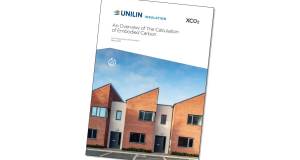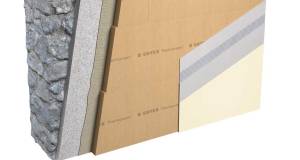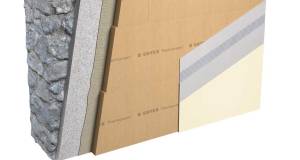 Patrick Duffy
Patrick Duffy
Energy Labels

As Construct Ireland goes to press, the construction industry awaits Ministers Dick Roche and Noel Dempsey to sign off the long overdue timetable for implementing the Energy Performance of Buildings Directive, a piece of legislation set to make energy performance a key factor in property sales. But can Ireland train up enough auditors to label buildings by January 2006? The answer, as Patrick Duffy of the National Irish Centre for Energy Rating (NICER) writes, is a resounding yes, if the will is there.
The ‘organs of state’ are presently wrestling with the mammoth task of implementing the Energy Performance of Buildings Directive (EPBD), which requires a variety of actions presenting a massive challenge in decisions, management and resources. I believe it can still be implemented in time, particularly if the State harnesses existing private-sector and other resources. If, however, the State follows its more usual sequential and incremental processes, then I fear it may now already be a year or so behind the timescale for introduction in 2006. However things might proceed, there can be no let-up in efforts to ensure that everything is running smoothly in quality and volume by January 2009.
To examine the possible ways of implementing the Directive with respect to the residential sector only, we can divide the target into three distinct groups; second-hand houses and apartments at point of sale, new residential units, and second-hand houses and apartments when they are being let or re-let.
The approaches are similar, but different enough to warrant separate consideration. In this article, I shall ignore the requirements of properties for let or rent, and shall concentrate firstly on the second-hand property for sale sector, before looking at the options for new dwellings.
Under the EPBD, all second hand dwellings for sale from January 2006 are required to obtain an energy label that prospective buyers may examine – rating the property on a common scale, and listing improvements that could be made. The details of how this is to be done will be decided by the Government, which will have to cover who is empowered to carry out labelling and what methodologies they may use, while dealing with quality assurance issues.
The demands posed by the Directive have naturally led to much curiosity regarding the size of the task and how many trained people are required, and how soon Ireland can start.
‘Methodology’ here refers solely to the calculation procedures and any implications they have for measurement and inspection.
From what we understand, the labelling is likely to be conducted by building professionals only; engineers, architects, and some others, whether at graduate level, or from technician level, remains to be seen. Successful completion of an approved course will probably be an additional requirement. Consequently, the drawing up and approval of courses will arise. NICER has had many requests from professionals to provide courses, and could organise them in some quantity, but SEI have said that, as the detail is not yet decided, they would prefer that we wouldn’t do so.

In spite of not advertising training services, NICER have been contacted by many qualified people requesting training who wish to add energy labelling to their existing skills, whether to set-up themselves up especially for the task or to add it as a second string to their bows. Some see it as an ideal non-commuting kind of home-office activity. Clearly, there will not be any shortage of the willing.
A good, prepared training course could train such (pre-qualified) people to proficiency in about a week. If we suppose they would each perform three audits per day, over 210 working days per year, then each trained person would issue 630 labels per year. To meet the demand to label, say, 70,000 ‘second-hand’ transactions per year, ignoring the new build, would therefore require about 1,100 auditors or labellers.
ifferent methodologies for labelling are under active consideration by the Government group, comprising of SEI, the Department of the Environment and the Department of Communications, Marine and Natural Resources. The Directive suggests the use of EN standards, and some 31 or so of these are well into preparation, but compliance with these will not be obligatory. Most standards are not obligatory, but enjoy a ‘deemed to satisfy’ status: standards issued under the Construction Products Directive (CPD) are obligatory and as such are among the exceptions, but the EPBD is a more ‘normal’ Directive in this regard. It will be interesting to see what approach will be taken here, as, on the one hand it isn’t desirable to have different methodologies, particularly if they give very different results, so a single approach would be preferable. On the other hand, organisations such as NICER, who have pioneered energy rating and labelling and developed software over the years with little reward, would be dismayed to see their efforts just discarded. It is debatable whether the Government has the power to impose particular methodologies, so such an approach could be open to challenge. One solution would be to carry out comparative studies of different methodologies so that they could then be used subject to some adjustment to establish common, repeatable results. Of course, if the relevant authorities wanted to move more quickly, any labelling performed now could be given slight adjustment if necessary at a later date when parameters are settled and in place.
This is a readily achievable average, based on our experience.
Quality Assurance and control will be vital. It appears that many ‘trained’ auditors in a number of countries have produced results that vary considerably. The first requirement for quality assurance is not quality, but consistency or repeatability. This needs to be addressed by the standardisation of approach and training, with feedback and correction. The ‘control’ part of this will likely consist of checking labels carried out on a sample basis, taking corrective action where required and eventually excluding labellers who fail to meet the required standards even when they have undertaken re-education.
As many of the standards that could inform the labelling methodology are not quite ready yet, it might be argued that we should wait until that process is finished before anything is done to put national systems in place. In this scenario, the process could be delayed to the extent that we are glad that the Directive actually gives us until January 2009 to have everything in full swing. And what’s wrong with that?
Well, nothing really, if you are a last-minute person for whom life is a series of narrowly-averted crises, or if you would not be embarrassed as an Irish man or woman with Ireland taking this approach. Certainly, man-for-man and woman-for-woman, SEI is as efficient and effective as any of its peers in Europe . But will it be big enough to perform the task while also guiding the Government? I would lay a bet that the percentage of parliamentarians in Ireland with a physical sciences background is the lowest in Europe , if anybody wants to take me on.
Being realistic, whatever plan is put in place we must anticipate that problems or snags of one kind or another are a distinct possibility, and presumably the three year period of grace afforded to the various National Governments is there precisely to cater for that. However, to have any margin for error or contingency – always advisable in a project – private-sector personnel, expertise and resources should be harnessed now, so that Ireland Incorporated doesn’t take 2009 as the real target.

Difficulties anticipated.
NICER’s experience is that, given broad details of construction type and area, we can predict the energy label of a property value fairly accurately without even doing any calculations – almost always within 10%, and usually better. This approach is not acceptable under the Directive. But however labelling is conducted, the main difficulties that arise are as follows:
1. What can’t be seen in a building?
What insulation, if any, is there, what is its thickness, how well is the insulation installed, and what are the air-tightness details?
It is possible to use a drill and endoscope to check cavities; thermal sensors and loggers could be used at high cost. Planning records might be used to tell what is supposed to be installed. But, how can you check what is under a solid floor? Are the planning records easily available? - Such checks could add significantly to cost, without much improving the accuracy of the results and for that reason are, we believe, unlikely to be called for.
2. Assigning values to some of the parameters or inputs
This relates to efficiencies of boilers and heating systems where there could be significant variances, to assigning values to insulation systems as built, and to air tightness. There is probably no alternative to the use of an agreed database that must be prepared, albeit recognising its limitations. Not all will be satisfied. Manufacturers and suppliers of equipment, systems and materials will seek their ‘place in the sun’, but must be prepared to advance sound technical arguments backed by independent test data. At present, for instance, there is insulation sold on the Irish market that appears to break the laws of physics, but of course it can’t and it doesn’t. However, by increasing air tightness, it is mistaken for improved insulation value.
3. ' Unusual’ properties
Most properties have simple regular dimensions – in plan, usually a rectangle or two rectangles, and for them an inspection template is easily prepared. Others, such as older larger properties may have additions, alterations, add-ons, different construction forms, and perhaps more complicated heating systems or more than one such system. These are, let’s say, ‘challenging’. The level of skill needed will be higher as not everything will fall readily into a template.
4. Labelling manpower
As we said above, approximately 1,100 auditors will be required for existing dwellings up for resale. To prepare such a body of auditors we should prepare a training programme now, within two months, with training to be offered at two or three locations in the state. Ireland could commence training of auditors, at an average of say 50 per week, where auditors pay for themselves, with the course culminating in evaluation; a test to qualify the auditor.
This could be supplemented by updating training material and providing a one day refresher course before the end of 2005 to cater for any slight variations in approaches adopted.
During 2006, I believe we should omit the rental sector, and instead label only houses for sale. This will also help prevent ‘misunderestimating’ or even ‘misoverestimating’ auditor numbers and would allow for adjustment.
There are potential bugs that might affect the energy labelling system, some of which could be as follows:
Scenario One
John Citizen doesn’t much like having to pay €300 for an energy label when he is selling his house: he also expects the label will not look good and so may make the sale more difficult. So he gets a label, in time, but makes it difficult for prospective buyers to actually get hold of it. “We’ll send it on”, his sales agent says, and it never arrives, or “certainly sir, that’ll be €25 for a copy”. How could this be policed? Perhaps the legislation could make it possible to subsequently challenge a sale if the label has not been readily available, free of charge, and / or a solution could be that the label of each property for sale must be presented on a controlled website, free of charge.
Scenario Two
Energy labelling is going full swing; good quality labels are being issued promptly. However nobody is using the recommendations in the Directive to improve the properties, and the whole exercise is turning out to be almost pointless. On investigation, it is found that Local Authorities are preventing, and there is a perception that they will prevent, any alterations, including the external appearance of walls, doors and windows, changes of material or colour, placing of solar panels on roofs, and perhaps alteration of internal details. As a solution here, local authorities, pro-actively and in advance, could zone roads, streets, and whole areas, to give clarity on planning matters that arise, so that works may proceed if done within the clear guidelines laid out.
Of course, as anyone in software will tell you, the way to reduce bugs to the point of elimination is to have users out there encountering the problems – so there’s a strong case for early piloting of labelling—in other words before 2006. One would hope that the people—presumably lawyers—who frame any legislation involved, will have a passing acquaintance with such and other possibilities.
This has been also requested to enable wind farm development to proceed.
If this started early summer, there are many suitable 3 rd level facilities that might be used over a 3-month period
There are a few flexibility options to facilitate the rapid implementation o f the directive, some of which are as follows:
Option One
All auditors use exactly the same system, including methodologies, software and so on. Data could be prepared on a laptop or Personal Digital Assistant, and emailed to a centre whence a label is issued. The auditor could point out any improvement approaches that should not be considered, and gives opinions on others. This is the relatively obvious way to proceed, however it would mean that property is sold with a label, but not improved by the vendor. Also, this is possibly the slowest way to deliver the desired numbers of labels.
Option Two
We could commence with agreement that experienced organisations may employ their existing methodologies. This would involve accepting that variances with eventual unified methodologies would be small and picked up at the next time of labelling. This approach lends itself to adaptation to best practice, could be used as forerunner to Option One, and could be rapidly introduced, with piloting and debugging. However, once again, the property would be sold with a label, but not improved by the vendor.
Option Three
We could introduce a two step process, where firstly the client self-certifies using the Internet, and inputs numbers, dimensions, construction details and so on. This would be inexpensive, perhaps costing as little as €15 per time. This step gives the client the possibility of implementing at least some improvements before activating the second step, where the auditor, armed with the foregoing detail, is called out to spot check some of the inputs. The visit would be far shorter and cheaper than a full audit, and could implement the labelling procedure. Aside from costing less, this approach would allow some improvements to be made before the sale, and would require less total manpower, although it is possible that auditors could be tricked or lulled into issuing a better label.
Hopefully mandatory elemental U-value levels will continue to be set for new build. In any event, energy design and performance should be evaluated by a labelling methodology.
Let’s assume that we are in the 21 st century and that Ireland no longer lags behind Europe in adapting broadband. Drawings can then be passed swiftly between centres, and energy labels can be rapidly produced at various centres by clicking on drawings and constructions. To make the process even easier, as this technology may be used in design, the originating architect or designer could fill out electronic datasheets as the required inputs to produce labels. These datasheets and their results might be separately evaluated by an independent centre, but, personally, I’d rather see inspection resources focused on on-site inspection, to ensure buildings are built to the plans, monitoring the quality of installing insulation and so on, with architects and engineers self-certifying the labels.
Labels could be separately archived. At a certain level of independent checking, self-certification is as efficacious as independent labelling. The real ‘meat’ is what happens on site, and that’s where I believe the checking should be done.
Thus, software used for calculation would essentially be the same for new build as for second-hand properties, but the graphical user interface could be quite different.
With so little time left before January 2006, fears are understandably growing that energy labelling will not be present from day one. But with focused hard work, flexibility and imagination this vital progress for the construction industry can be realised, and realised on time.
- Energy Performance of Buildings Directive
- auditors
- NICER
- National Irish Centre for Energy Rating
- EPBD
- Dick Roche
- Patrick Duffy
- insulation
Related items
-
 New Ejot profile cuts thermal bridging losses by 25mm insulation equivalent
New Ejot profile cuts thermal bridging losses by 25mm insulation equivalent -
 Ireland’s first 3D printed homes insulated with clay foam
Ireland’s first 3D printed homes insulated with clay foam -
 Embodied carbon & zero emission targets adopted in new EPBD
Embodied carbon & zero emission targets adopted in new EPBD -
 Unilin Ireland launches embodied carbon report
Unilin Ireland launches embodied carbon report -
EU votes through EPBD recast
-
 Ecological launches Retro EcoWall for internal wall insulation
Ecological launches Retro EcoWall for internal wall insulation -
 Xtratherm name changes to Unilin
Xtratherm name changes to Unilin -
 Ecological Building Systems launch Retro EcoWall for internal wall insulation
Ecological Building Systems launch Retro EcoWall for internal wall insulation -
 Kore launches low carbon EPS
Kore launches low carbon EPS -
 Kilsaran gets NSAI cert for EWI to steel frame
Kilsaran gets NSAI cert for EWI to steel frame -
 Steico offering free wood fibre insulation samples
Steico offering free wood fibre insulation samples -
 Top 5 questions about specifying structural thermal breaks
Top 5 questions about specifying structural thermal breaks
